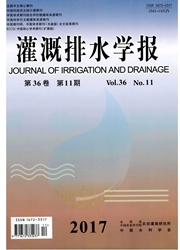

 中文摘要:
中文摘要:
采用盆栽试验,以常规灌溉为对照(CK),研究了水稻在分蘖期轻度旱涝交替胁迫(T-LD)和重度旱涝交替胁迫(T-HD)前、后及复水后各个生育期的部分生理指标变化,以探讨旱涝交替胁迫对水稻生长影响的机理。结果表明,T-LD处理的水稻叶片硝酸还原酶(NR)活性显著高于T-HD处理和CK;与CK相比,旱涝交替胁迫处理显著降低了水稻叶片中丙二醛(MDA)的质量摩尔浓度和谷氨酰胺合成酶(GS)活性,显著增加了水稻叶片中叶绿素总量;复水后(黄熟期)GS活性均明显提高并高于CK。说明分蘖期旱涝交替胁迫可以增强水稻叶片的生理活性,延缓叶片衰老,不会降低水稻后期的耐淹能力。
 英文摘要:
英文摘要:
This paper investigated the impact of alternating waterlogging and drought during the tillering stage on physiological traits of rice using pot experiments. We considered both slight waterlogging-drought alternation (T- LD) and severe waterlogging-drought alternation (T-HD). Main physiological traits were measured before, during and after occurrence of these stresses. The results showed that the activity of nitrate reductase in the leaves under T-LD was higher than those under T-HD and CK (conventional flooding). In comparison with those under CK, the concentration of malondialdehyde and the activity of glutamine synthetase (GS) under T-LD and T-HD de- creased significantly, while the concentration of chlorophyll increased. At ripening stage after re-watering, the ac- tivity of GS increased considerably and was higher than that under the CK, indicating that a moderate waterlog- ging-drought alternation during tillering stage can enhance physiological activity of the rice and delayed senes- cence without scarifying tolerance of the rice to flooding.
 同期刊论文项目
同期刊论文项目
 同项目期刊论文
同项目期刊论文
 期刊信息
期刊信息
